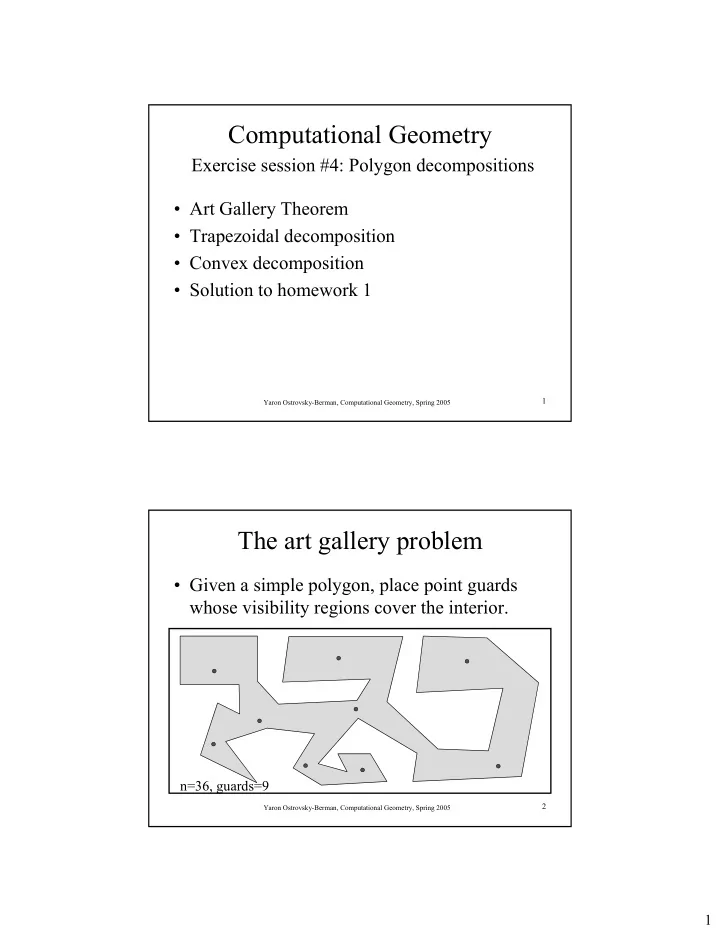

Computational Geometry Exercise session #4: Polygon decompositions • Art Gallery Theorem • Trapezoidal decomposition • Convex decomposition • Solution to homework 1 1 Yaron Ostrovsky-Berman, Computational Geometry, Spring 2005 The art gallery problem • Given a simple polygon, place point guards whose visibility regions cover the interior. n=36, guards=9 2 Yaron Ostrovsky-Berman, Computational Geometry, Spring 2005 1
Art Gallery Theorem • Theorem : For any simple polygon, ⎣ n /3 ⎦ point guards are sufficient to guard the entire polygon. A placement of ⎣ n /3 ⎦ guards can be computed in O ( n log n ) time. • Proof idea: triangulate polygon, then position guards to cover each triangle. 3 Yaron Ostrovsky-Berman, Computational Geometry, Spring 2005 Placing the guards 4 Yaron Ostrovsky-Berman, Computational Geometry, Spring 2005 2
3-Coloring of Polygon Vertices Green: 8 Black: 8 White: 9 5 Yaron Ostrovsky-Berman, Computational Geometry, Spring 2005 Correctness & Complexity • Dual graph of triangulation is a tree. • BFS traversal of tree visits vertices once. • Neighboring triangle vertices get different colors. • One vertex guard sees the vertices of different colors. • Running time: triangulation + linear traversal of dual graph. Can be done in O ( n ) time. 6 Yaron Ostrovsky-Berman, Computational Geometry, Spring 2005 3
Guarding with Edge guards How many edge guards are needed to guard a gallery? 7 Yaron Ostrovsky-Berman, Computational Geometry, Spring 2005 Lower bound for edge guards ⎣ n /4 ⎦ edge guards needed What about star-shaped polygons? 8 Yaron Ostrovsky-Berman, Computational Geometry, Spring 2005 4
Trapezoidal decomposition • Trapezoids are quadrilaterals with two parallel edges, or triangles (degenerate case). • Trapezoids are easily triangulated. • Decompose polygon into slabs which are easily searched. • Computation using sweep line is easily achieved. • Drawback: new vertices are added to the decomposition. 9 Yaron Ostrovsky-Berman, Computational Geometry, Spring 2005 Example 10 Yaron Ostrovsky-Berman, Computational Geometry, Spring 2005 5
Sweep events I e 1 e 4 e 2 e 3 v Sweepline status: ( e 1 , e 2 , e 3 , e 4 ) � ( e 1 , e 4 ) 11 Yaron Ostrovsky-Berman, Computational Geometry, Spring 2005 Sweep events II v e 1 e 4 e 3 e 2 Sweepline status: ( e 1 , e 4 ) � ( e 1 , e 2 , e 3 , e 4 ) 12 Yaron Ostrovsky-Berman, Computational Geometry, Spring 2005 6
Sweep events III e 2 v e 4 e 1 e 3 Sweepline status: ( e 1 , e 2 , e 4 ) � ( e 1 , e 3 , e 4 ) 13 Yaron Ostrovsky-Berman, Computational Geometry, Spring 2005 Convex decompositions • Partition polygon into minimal number of convex pieces with disjoint interiors such they cover the polygon. • Two versions: � Partition using only diagonals � Partition with additional vertices (‘Steiner points’) • For a given polygon, which version results in less convex pieces? • Which is harder to compute? 14 Yaron Ostrovsky-Berman, Computational Geometry, Spring 2005 7
Decomposition example Decomposition with diagonals Decomposition with Steiner points 15 Yaron Ostrovsky-Berman, Computational Geometry, Spring 2005 Bounds on optimal decomposition • Let Φ be the fewest number of convex pieces into which a polygon may be partitioned. • Theorem : for a polygon of r reflex vertices: ⎡ r /2 ⎤+1 ≤ Φ ≤ r +1 • Proof : � Drawing a segment that bisects a reflex vertex removes all reflex angles � upper bound (Steiner). � At most two reflex angles can be resolved by a single segment � lower bound (both versions). 16 Yaron Ostrovsky-Berman, Computational Geometry, Spring 2005 8
4-Approximation algorithm • Hertel & Melhorn 1983. • Quickly partition polygon such that number of pieces is at most four times the optimal. • Definition : a diagonal d is essential for vertex v if removal of d creates a non-convex piece. Otherwise it is inessential . • Algorithm : triangulate, then remove inessential diagonals one after one until none remain. 17 Yaron Ostrovsky-Berman, Computational Geometry, Spring 2005 Quality of approximation • Algorithm outputs convex partitions, since it starts with one and maintains this invariant throughout all steps. • Lemma 1 : There can be at most two diagonals essential for any reflex vertex. • Lemma 2: The Hertel-Melhorn algorithm is never worse than four times the optimal number of pieces. 18 Yaron Ostrovsky-Berman, Computational Geometry, Spring 2005 9
Proof of lemma 1 b H + H - c v a v - v + 19 Yaron Ostrovsky-Berman, Computational Geometry, Spring 2005 Proof of lemma 2 • When algorithm terminates, all diagonals are essential. • According to lemma 1, every reflex vertex is responsible for at most 2 diagonals. • Number of diagonals cannot be more than 2 r . • Number of convex pieces produced: M ≤ 2 r +1. • Lower bound for Φ implies M ≤ 4Φ . 20 Yaron Ostrovsky-Berman, Computational Geometry, Spring 2005 10
Optimal Convex partitioning • Best algorithm for partitioning with diagonals: [Keil, 1985], runs in O ( r 2 n log n ) time. • Best algorithm for partitioning with Steiner points: [Chazelle, 1980], runs in O ( n + r 3 ) time. 21 Yaron Ostrovsky-Berman, Computational Geometry, Spring 2005 11
Recommend
More recommend